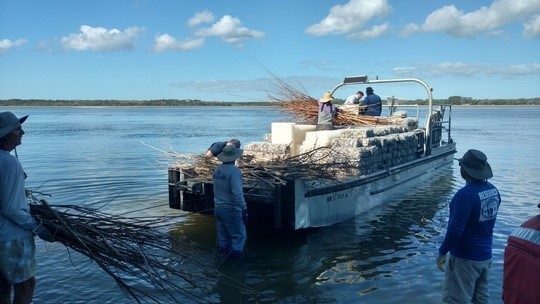FOR IMMEDIATE RELEASE: April 20, 2017
GTM
Research Reserve Re-Engineers Living Shorelines with New Program
~Pilot program will re-engineer living shorelines for high-energy coastal environments~

GTM staff and volunteers unload gabions and BESE for
installation.
(Photo courtesy of Dorothy Wickline)
PONTE VEDRA BEACH, Fla. – The Guana Tolomato Matanzas (GTM) Research Reserve recently began a project that will test the effectiveness of a new strategy for protecting coastal habitat in high-energy environments. The experimental study will integrate engineering and ecological approaches by deploying gabion-breaks, a hybrid method for building living shorelines to protect and restore coastlines. The
project is anticipated to create stable shorelines, restore oyster reefs
and enhance biodiversity along reaches of the GTM Research Reserve and
Northeast Florida Aquatic Preserves.
"GTM Research Reserve is partnering with other scientists, ecologists, engineers and educators to develop innovative engineering and ecological approaches to address loss of salt marshes and oyster reefs," said Andrea Noel, manager of the Northeast Florida Aquatic Preserves. "We are excited to bring this innovative system to the Reserve to advance our restoration efforts."
This new study, which is led by Dr. Christine Angelini, assistant professor at the University of Florida, tests the potential for Biodegradable Element for Starting Ecosystems (BESE), a potato waste-based, mass-manufactured product, to successfully restore oysters, salt marsh grasses, mangroves, submerged aquatic vegetation, sponges and corals. At each of the six installation sites, staff and volunteers staged an equal number of gabions, wire cages filled with oyster shell, and BESE behind previously installed break walls 10 ft. from the marsh edge to compare the success of BESE against another living shoreline method.
The
Intracoastal Waterway in the northern portion of the GTM Research Reserve, an
area with heavy wave and boat traffic, was selected for this study to serve as
an example on a small scale of the erosion occurring along the East Coast. The Reserve noted a decline in intertidal oyster reefs and marsh erosion due to these high-energy conditions. The goal through this pilot program is to find a more stable and lasting solution for halting erosion and restoring coastal habitat functioning in those environments.
For more information about this project, contact Andrea Noel at 904-823-4500.
|